Detection of Ultrasonic Stress Waves in Structures Using 3D Shaped Optic Fiber Based on a Mach–Zehnder Interferometer
Abstract
:1. Introduction
2. Mach–Zehnder Interferometer and the Fiber Optic Sensor
2.1. The Principle of Mach–Zehnder Interferometers
2.2. The 3D Shaped Ultrasonic Fiber Optic Sensor
3. Feasibility Analysis Using the Finite Element Model
4. Experimental Investigations on the Specimens
4.1. Experiments on the Aluminum Plate
4.2. Experiments on the Reinforced Concrete Beam
5. Conclusions
Acknowledgments
Author Contributions
Conflicts of Interest
Abbreviations
| AE | Acoustic emission |
| EMAT | Electromagnetic acoustic transducer |
| FOS | Fiber optic sensor |
| UFOS | Ultrasonic fiber optic sensor |
| LVDT | Linear variable differential transformer |
References
- Rokhlin, S. Diffraction of Lamb waves by a finite crack in an elastic layer. J. Acoust. Soc. Am. 1980, 67, 1157–1165. [Google Scholar] [CrossRef]
- Alleyne, D.; Cawley, P. The interaction of Lamb waves with defects. IEEE Trans. Ultrason. Ferroelectr. Freq. Control 1992, 39, 381–397. [Google Scholar] [CrossRef] [PubMed]
- Cawley, P.; Alleyne, D. The use of Lamb waves for the long range inspection of large structures. Ultrasonics 1996, 34, 287–290. [Google Scholar] [CrossRef]
- He, J.; Yuan, F. Damage identification for composite structures using a cross-correlation reverse-time migration technique. Struct. Health Monit. 2015, 14, 558–570. [Google Scholar] [CrossRef]
- He, J.; Yuan, F. Lamb wave-based subwavelength damage imaging using the DORT-MUSIC technique in metallic plates. Struct. Health Monit. 2016, 15, 65–80. [Google Scholar] [CrossRef]
- He, J.; Yuan, F.G. A quantitative damage imaging technique based on enhanced CCRTM for composite plates using 2D scan. Smart Mater. Struct. 2016, 25, 105022. [Google Scholar] [CrossRef]
- Zhang, G.; Gao, W.; Song, G.; Song, Y. An imaging algorithm for damage detection with dispersion compensation using piezoceramic induced lamb waves. Smart Mater. Struct. 2016, 26, 025017. [Google Scholar] [CrossRef]
- Mitra, M.; Gopalakrishnan, S. Guided wave based structural health monitoring: A review. Smart Mater. Struct. 2016, 25, 053001. [Google Scholar] [CrossRef]
- Wang, L.; Yuan, F.G. Damage identification in a composite plate using prestack reverse-time migration technique. Struct. Health Monit. 2005, 4, 195–211. [Google Scholar] [CrossRef]
- Lin, X.; Yuan, F.G. Experimental study applying a migration technique in structural health monitoring. Struct. Health Monit. 2005, 4, 341–353. [Google Scholar] [CrossRef]
- Kwun, H.; Teller, C. Magnetostrictive generation and detection of longitudinal, torsional, and flexural waves in a steel rod. J. Acoust. Soc. Am. 1994, 96, 1202–1204. [Google Scholar] [CrossRef]
- Light, G.; Kwun, H.; Kim, S.; Spinks, R.J. Health monitoring of piping and plate using the Magnetostrictive Sensor (MsS) guided-wave technology. In Proceedings of the Second Middle East Nondestructive Testing Conference and Exhibition, Jubail, Saudi Arabia, 8–10 December 2003. [Google Scholar]
- Gao, H.; Ali, S.; Lopez, B. Efficient detection of delamination in multilayered structures using ultrasonic guided wave EMATs. NDT E Int. 2010, 43, 316–322. [Google Scholar] [CrossRef]
- Matt, H.M.; di Scalea, F.L. Macro-fiber composite piezoelectric rosettes for acoustic source location in complex structures. Smart Mater. Struct. 2007, 16, 1489–1499. [Google Scholar] [CrossRef]
- Glushkov, E.; Glushkova, N.; Kvasha, O.; Kern, D.; Seemann, W. Guided wave generation and sensing in an elastic beam using MFC piezoelectric elements: theory and experiment. J. Intell. Mater. Syst. Struct. 2010, 21, 1617–1625. [Google Scholar] [CrossRef]
- Sorazu, B.; Thursby, G.; Culshaw, B.; Dong, F.; Pierce, S.; Yang, Y.; Betz, D. Optical generation and detection of ultrasound. Strain 2003, 39, 111–114. [Google Scholar] [CrossRef]
- Lau, K.; Chan, C.; Zhou, L.; Jin, W. Strain monitoring in composite-strengthened concrete structures using optical fibre sensors. Compos. Pt. B-Eng. 2001, 32, 33–45. [Google Scholar] [CrossRef]
- Inaudi, D.; Ruefenacht, A.; von Arx, B.; Noher, H.; Vurpillot, S.; Glisic, B. Monitoring of a concrete arch bridge during construction. Smart Structures and Materials 2002: Smart Systems for Bridges, Structures, and Highways. In Proceedings of the SPIE’s 9th Annual International Symposium on Smart Structures and Materials, San Diego, CA, USA, 17–21 March 2002; Volume 4696, pp. 146–153. [Google Scholar]
- Pinet, E.; Hamel, C.; Glisic, B.; Inaudi, D.; Miron, N. Health monitoring with optical fiber sensors: From human body to civil structures. In Proceedings of the SPIE—The International Society for Optical Engineering, San Diego, CA, USA, 18–22 March 2007; Volume 6532. [Google Scholar]
- Kim, T.; Kim, D.H.; Kim, M.; Lim, Y. Fiber Bragg grating-based long-gauge fiber optic sensor for monitoring of a 60 m full-scale prestressed concrete girder during lifting and loading. Sens. Actuator A Phys. 2016, 252, 134–145. [Google Scholar] [CrossRef]
- Khalil, A.; Nader, V.; Paul, R.; Lydia, L.; Oleg, S. Strain based FBG sensor for real-time corrosion rate monitoring in pre-stressed structures. Sens. Actuator B Chem. 2016, 236, 276–285. [Google Scholar]
- Lawson, N.; Correia, R.; James, S.; Partridge, M.; Staines, S.; Gautrey, J.; Garry, K.; Holt, J.; Tatam, R. Development and application of optical fibre strain and pressure sensors for in-flight measurements. Meas. Sci. Technol. 2016, 27, 104001. [Google Scholar] [CrossRef]
- Ravet, F.; Zou, L.; Bao, X.; Ozbakkaloglu, T.; Saatcioglu, M.; Zhou, J. Distributed Brillouin sensor for structural health monitoring. Can. J. Civ. Eng. 2007, 34, 291–297. [Google Scholar] [CrossRef]
- Bucaro, J.; Dardy, H.; Carome, E. Optical fiber acoustic sensor. Appl. Opt. 1977, 16, 1761–1762. [Google Scholar] [CrossRef] [PubMed]
- Gachagan, A.; Pierce, S.; Philp, W.; Mcnab, A.; Hayward, G.; Culshaw, B. Detection of ultrasoncis Lamb waves in composite plates using optical-fibers. In Proceedings of the IEEE Ultrasoncis Symposium, Seattle, WA, USA, 7–10 November 1995; pp. 803–806. [Google Scholar]
- Gachagan, A.; Hayward, G.; McNab, A.; Reynolds, P.; Pierce, S.; Philp, W.; Culshaw, B. Generation and reception of ultrasonic guided waves in composite plates using conformable piezoelectric transmitters and optical-fiber detectors. IEEE Trans. Ultrason. Ferroelectr. Freq. Control 1999, 46, 72–81. [Google Scholar] [CrossRef] [PubMed]
- Zhou, Y.; Jin, S.; Qu, Z. Study on the distributed optical fiber sensing technology for pipeline leakage detection. In Advanced Laser Technologies 2005; Society of Photo-Optical Instrumentation Engineers (SPIE): Tianjin, China, 2005; Volume 6344. [Google Scholar]
- Culshaw, B.; Dakin, J. Optical Fiber Sensors: Systems and Applications; Artech House: Norwood, MA, USA, 1989; Volume 2. [Google Scholar]
- Dong, F.; Atherton, K.; Pierce, G.; Culshaw, B. Measurement of in-plane and out-of-plane displacement for ultrasonic flaw detection. In Proceedings of the 5th European Conference on Smart Structures and Materials, Glasgow, UK, 21–25 May 2000; Volume 4073. [Google Scholar]
- Liang, Y.; Qu, D.; Deng, H. Based on optical fiber Michelson interferometer for acoustic emission detection experimental research. In Proceedings of the International Symposium on Photoelectronic Detection and Imaging 2013: Fiber Optic Sensors and Optical Coherence Tomography (SPIE), Beijing, China, 25–27 June 2013; Volume 8914. [Google Scholar]
- Alcoz, J.; Lee, C.; Taylor, H. Embedded fiber-optic fabry-perot ultrasound sensor. IEEE Trans. Ultrason. Ferroelectr. 1990, 37, 302–306. [Google Scholar] [CrossRef] [PubMed]
- Oliveira, R.; Ramos, C.; Marques, A. Health monitoring of composite structures by embedded FBG and interferometric Fabry–Pérot sensors. Comput. Struct. 2008, 86, 340–346. [Google Scholar] [CrossRef]
- Fomitchov, P.; Kromine, A.; Krishnaswamy, S.; Achenbach, J. Sagnac-type fiber-optic array sensor for detection of bulk ultrasonic waves. IEEE Trans. Ultrason. Ferroelectr. Freq. Control 2000, 47, 584–590. [Google Scholar] [CrossRef] [PubMed]
- Harish, A.; Varghese, B.; Rao, B.; Balasubramaniam, K.; Srinivasan, B. Dynamic interrogator for elastic wave sensing using Fabry Perot filters based on fiber Bragg gratings. Ultrasonics 2015, 60, 103–108. [Google Scholar] [CrossRef] [PubMed]
- Kageyama, K.; Murayama, H.; Ohsawa, I.; Kanai, M.; Nagata, K.; Machijima, Y.; Matsumura, F. Acoustic emission monitoring of a reinforced concrete structure by applying new fiber-optic sensors. Smart Mater. Struct. 2005, 14, S52–S59. [Google Scholar] [CrossRef]
- Li, F.; Murayama, H.; Kageyama, K.; Shirai, T. Doppler effect-based fiber-optic sensor and its application in ultrasonic detection. Opt. Fiber Technol. 2009, 15, 296–303. [Google Scholar] [CrossRef]
- Zhou, W.; Li, H.; Dong, Y.; Wang, A. Sensing properties of optical fiber sensor to ultrasonic guided waves. Smart Struct. Syst. 2016, 18, 471–484. [Google Scholar] [CrossRef]
- Wei, P.; Han, X.; Xia, D.; Liu, T.; Lang, H. Novel fiber-optic ring acoustic emission sensor. Sensors 2018, 18, 215. [Google Scholar]
- Hocker, G. Fiber-optic sensing of pressure and temperature. Appl. Opt. 1979, 18, 1445–1448. [Google Scholar] [CrossRef] [PubMed]
- Rose, J.L. Ultrasonic Guided Waves in Solid Media; Cambridge University Press: Cambridge, UK, 2014. [Google Scholar]
- Ohno, K.; Ohstu, M. Crack classification in concrete based on acoustic emission. Constr. Build. Mater. 2010, 24, 2339–2346. [Google Scholar] [CrossRef]
- Aldahdooh, M.; Bunnori, N.; Johari, M. Damage evaluation of reinforced concrete beams with varying thickness using the acoustic emission technique. Constr. Build. Mater. 2013, 44, 812–821. [Google Scholar] [CrossRef]
- Kocur, G.; Saenger, E.; Grosse, C.; Vogel, T. Time reverse modeling of acoustic emissions in a reinforced concrete beam. Ultrasonics 2016, 65, 96–104. [Google Scholar] [CrossRef] [PubMed]
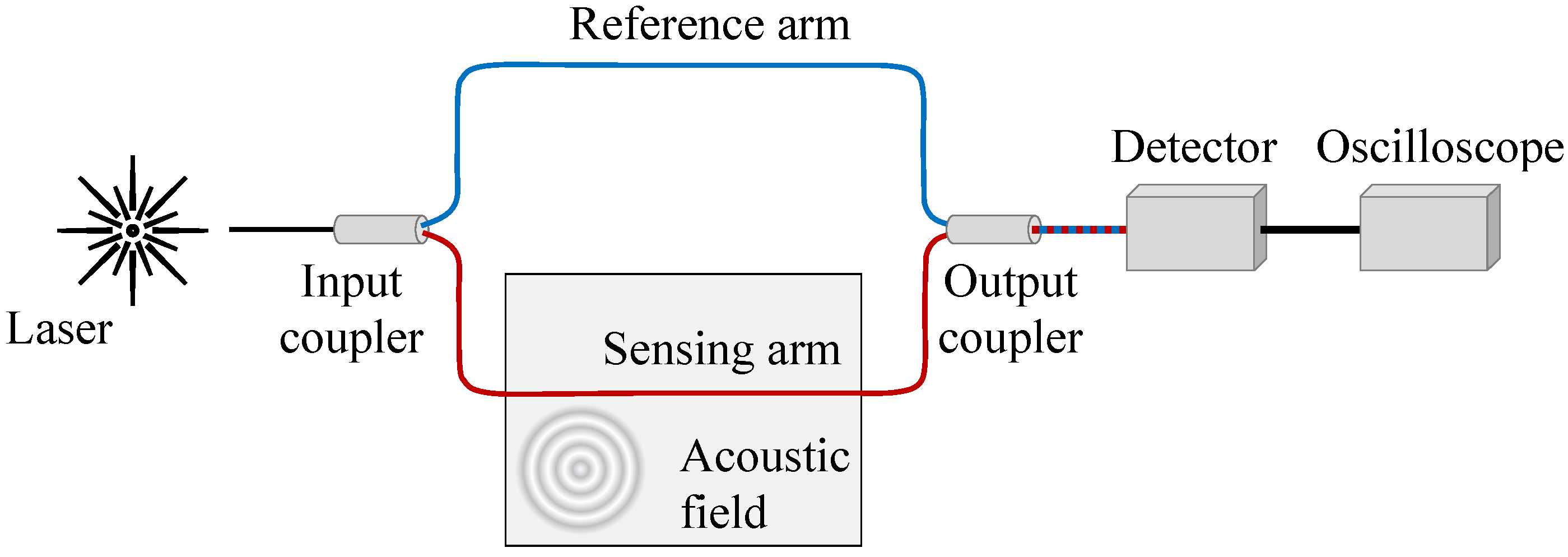


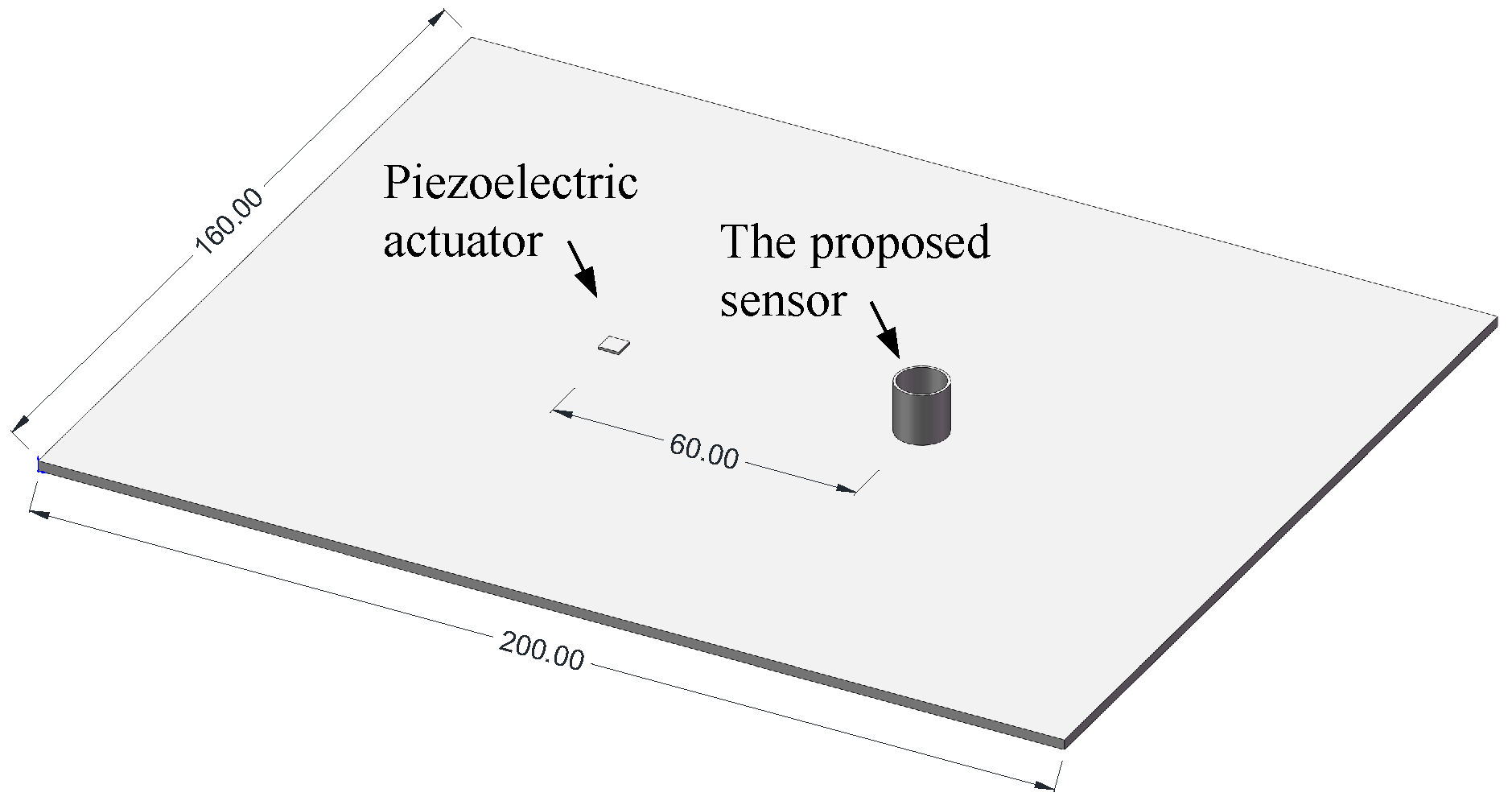
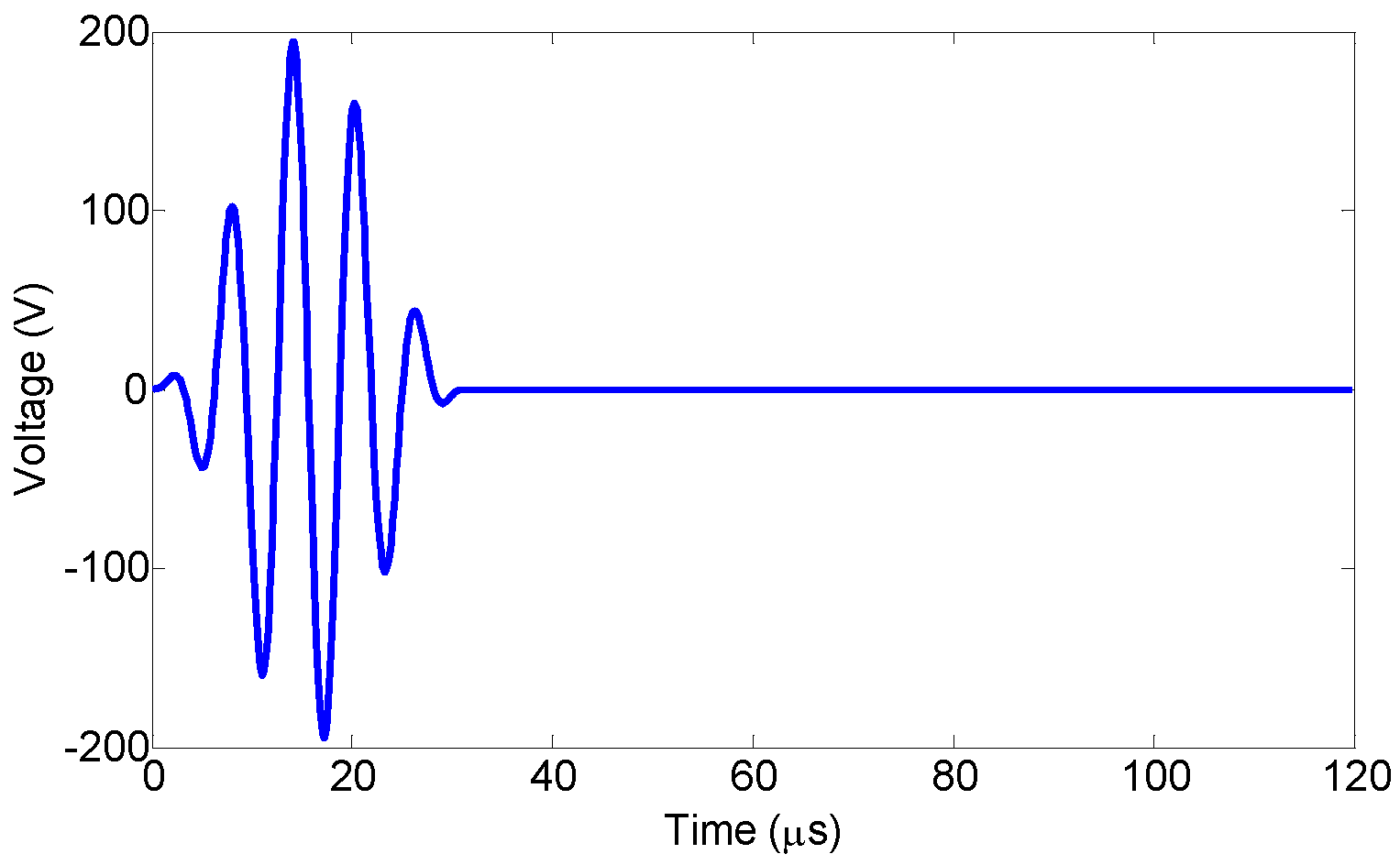
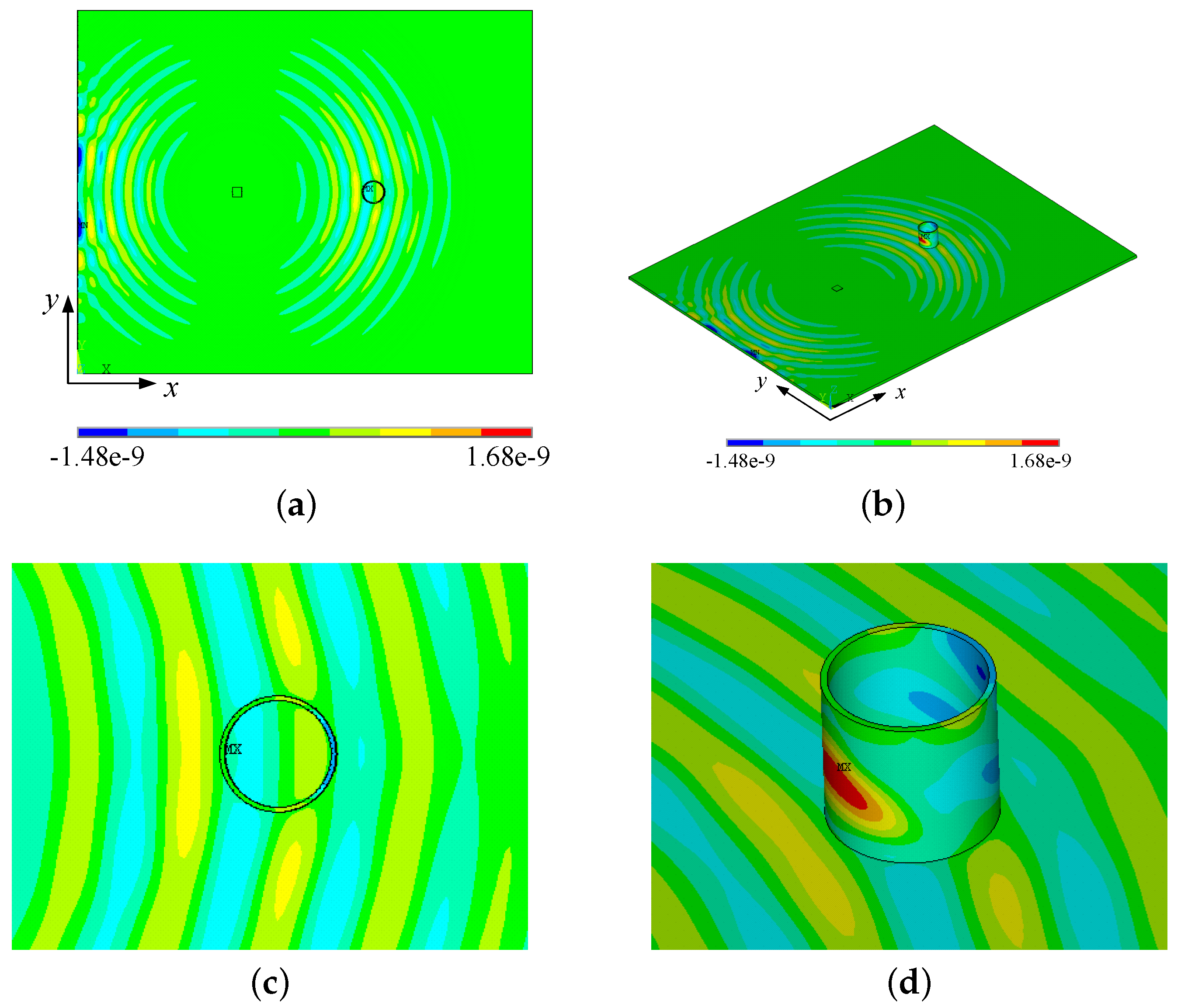
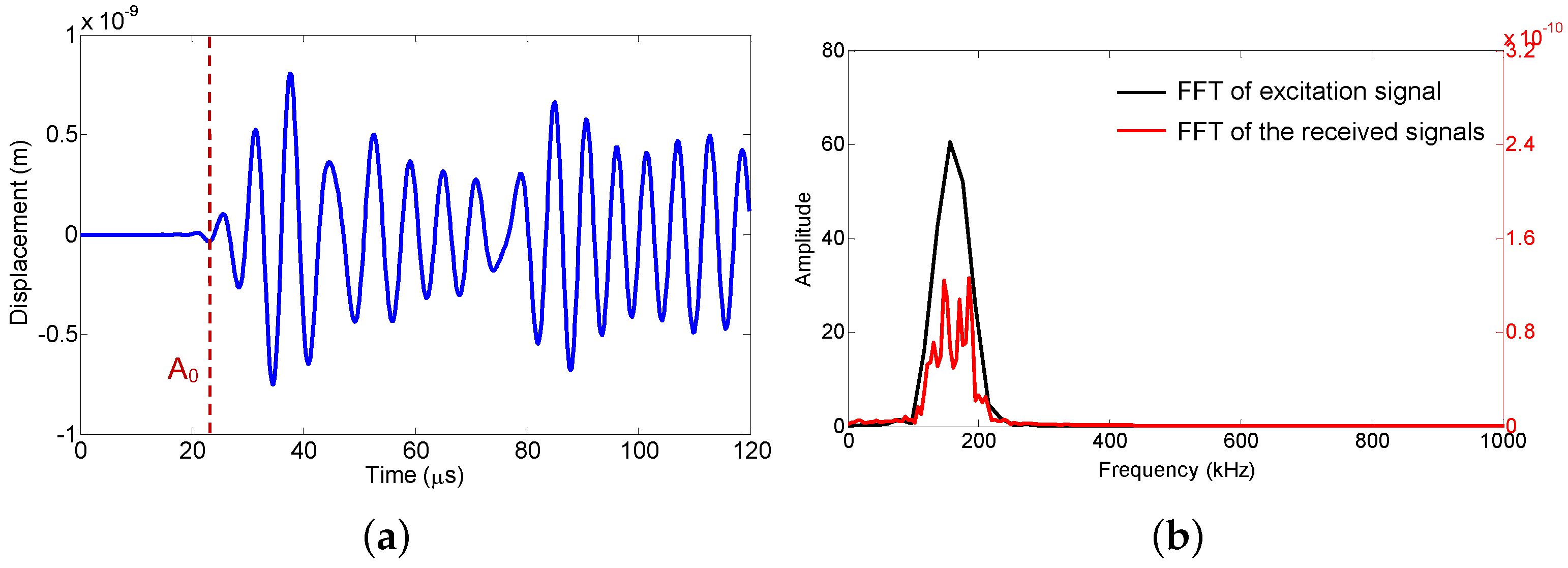


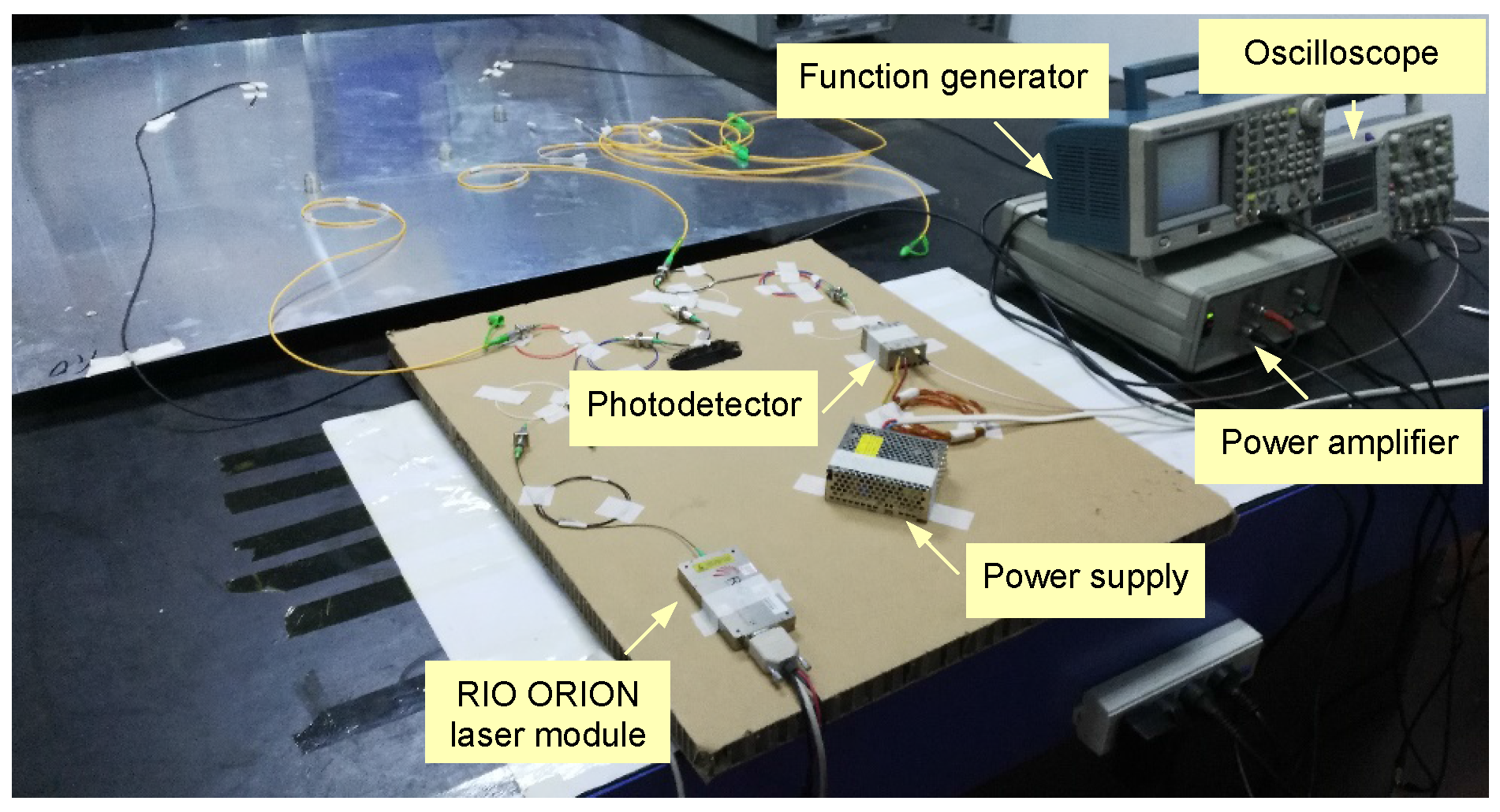
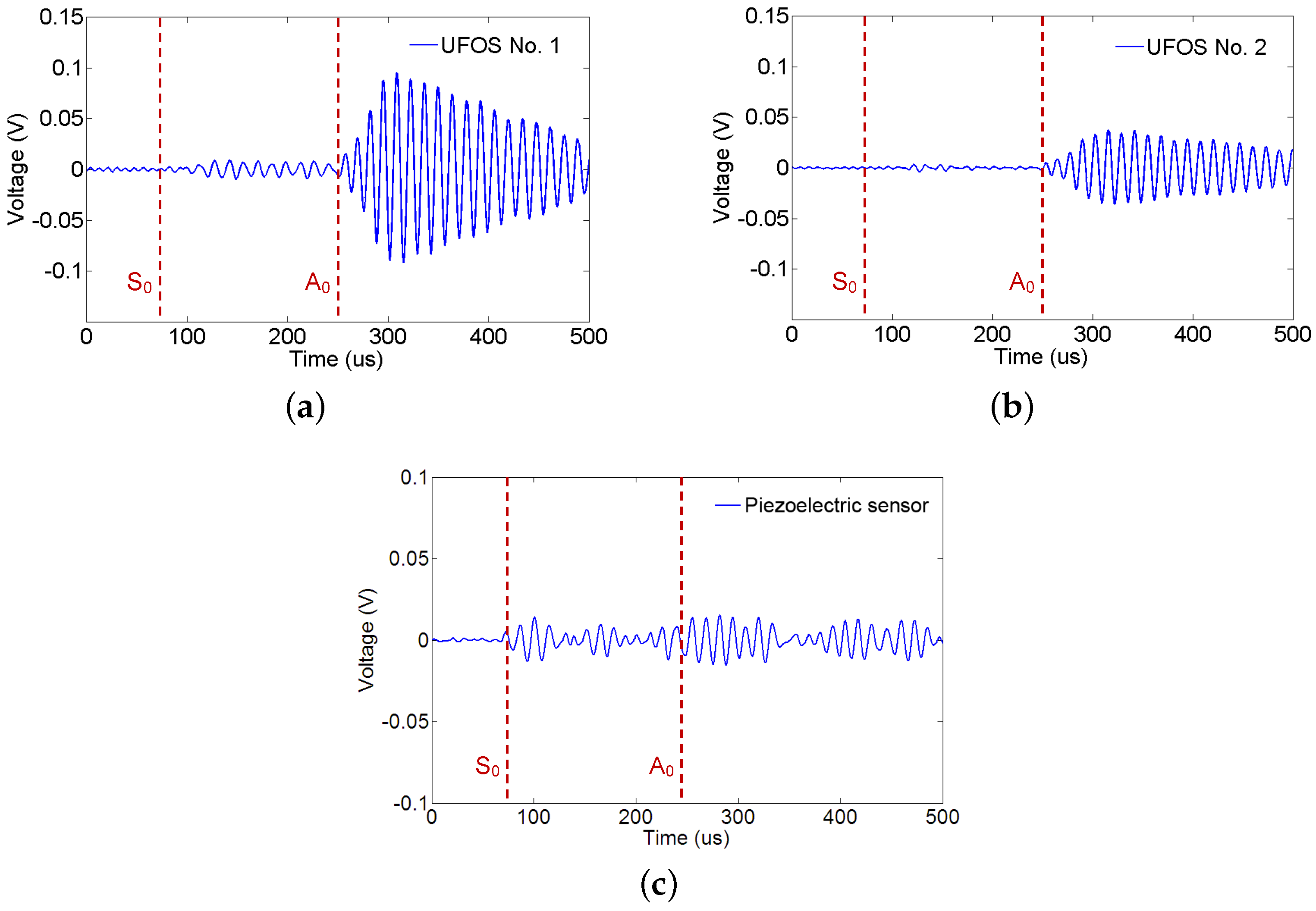
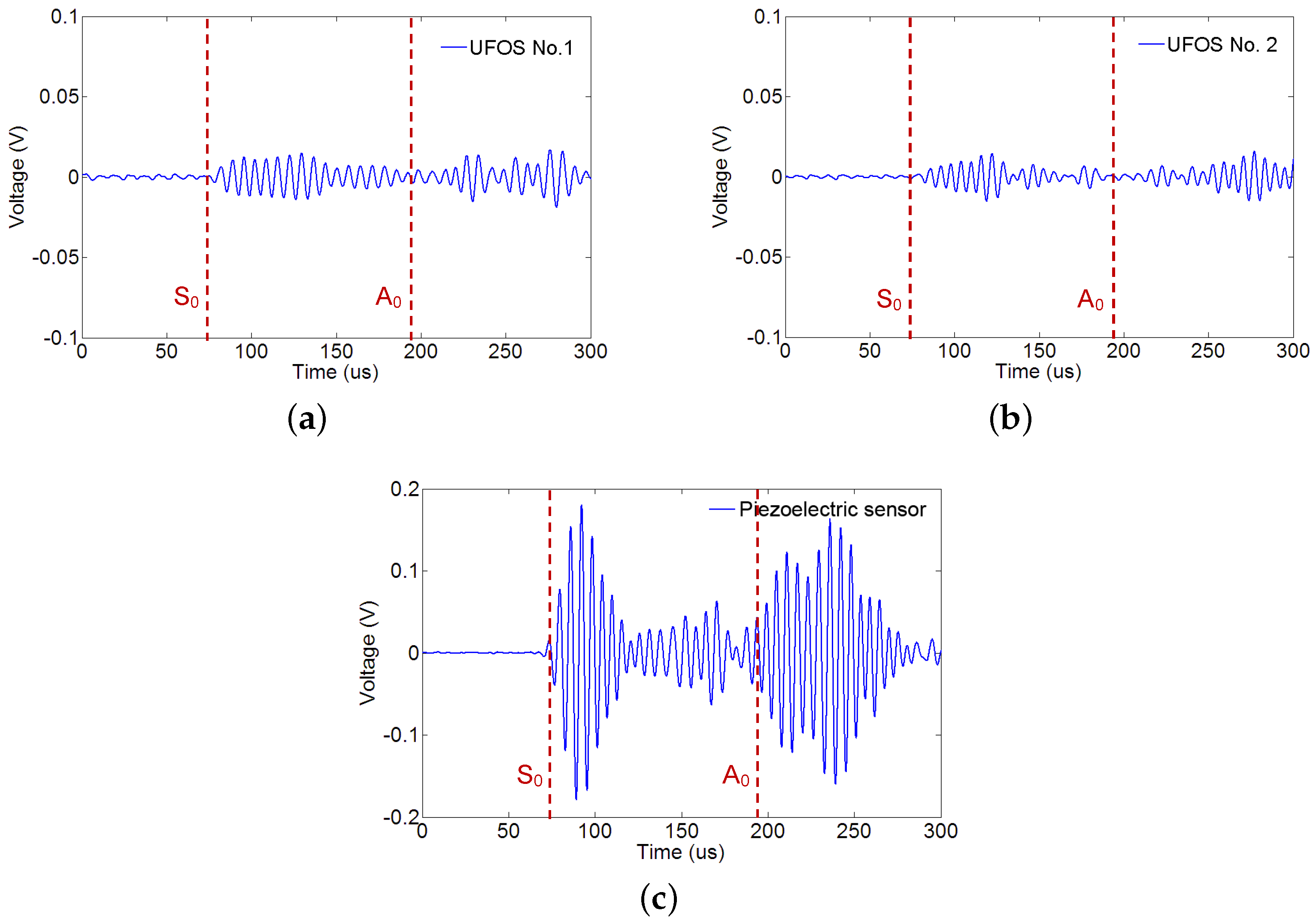

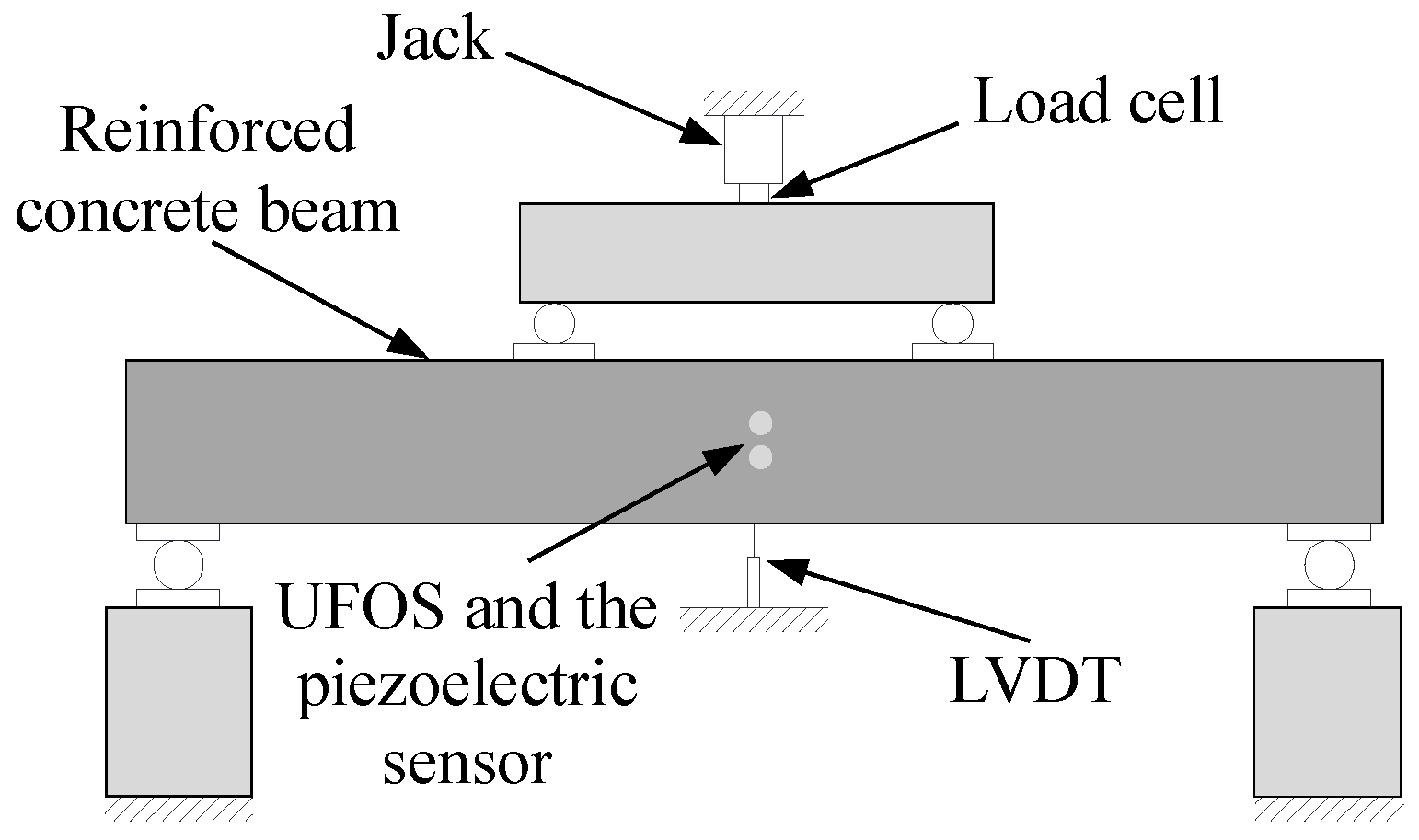
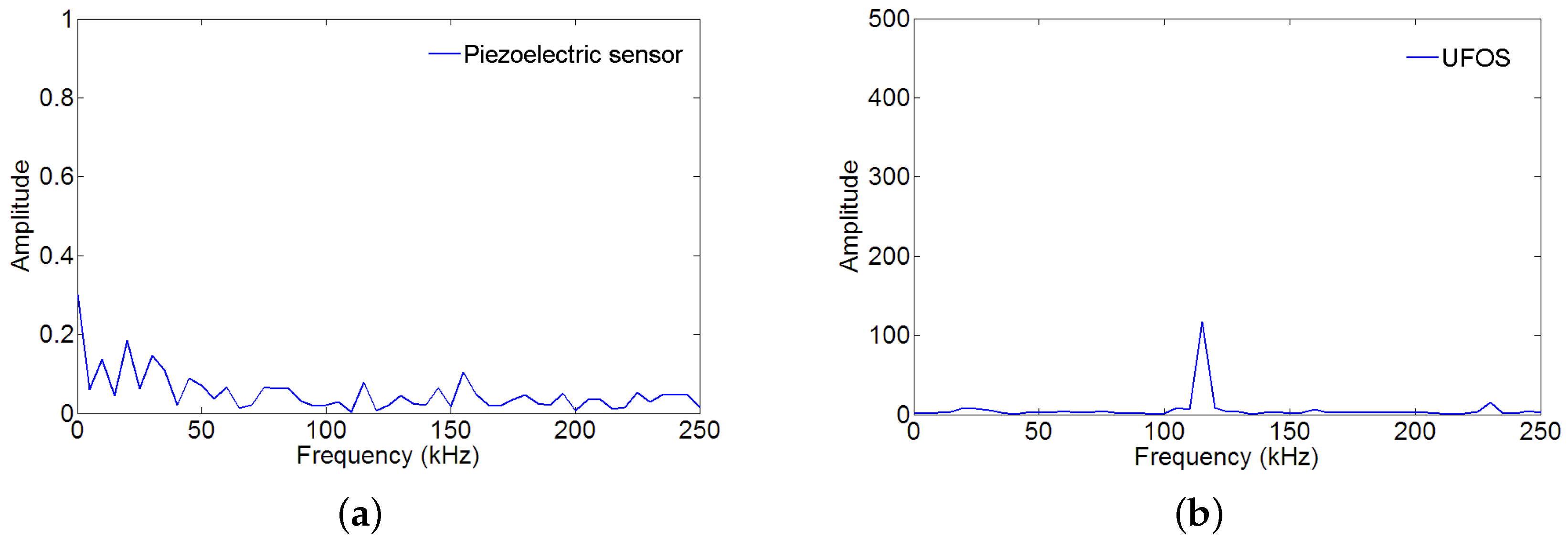
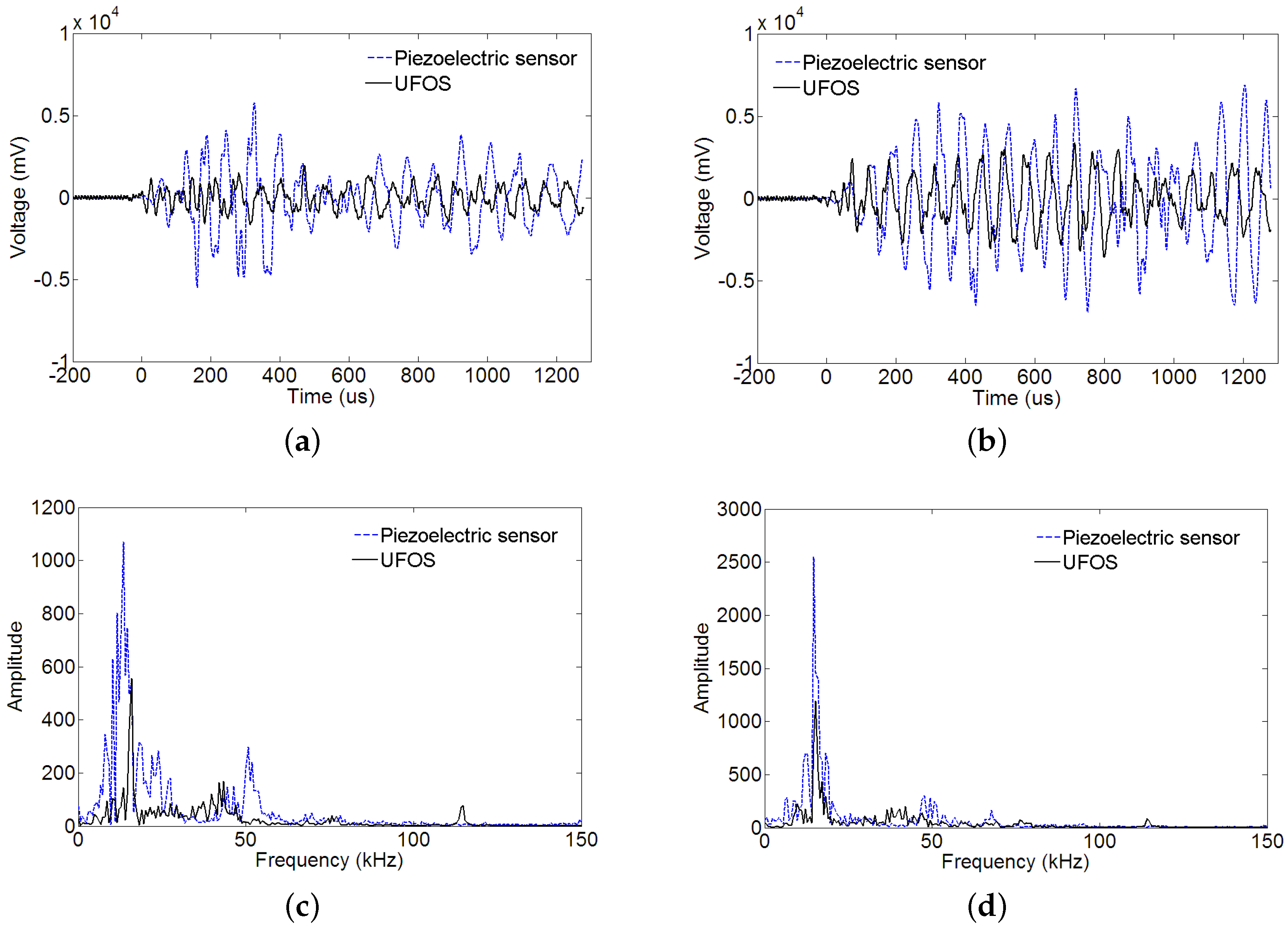
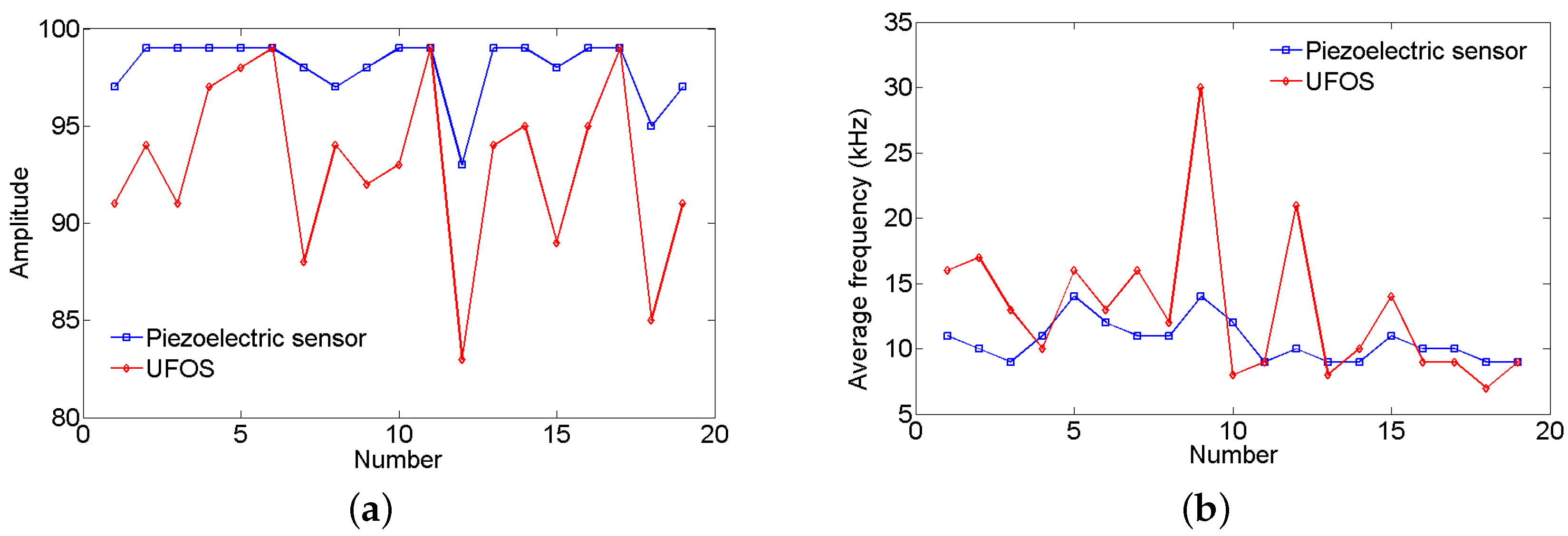
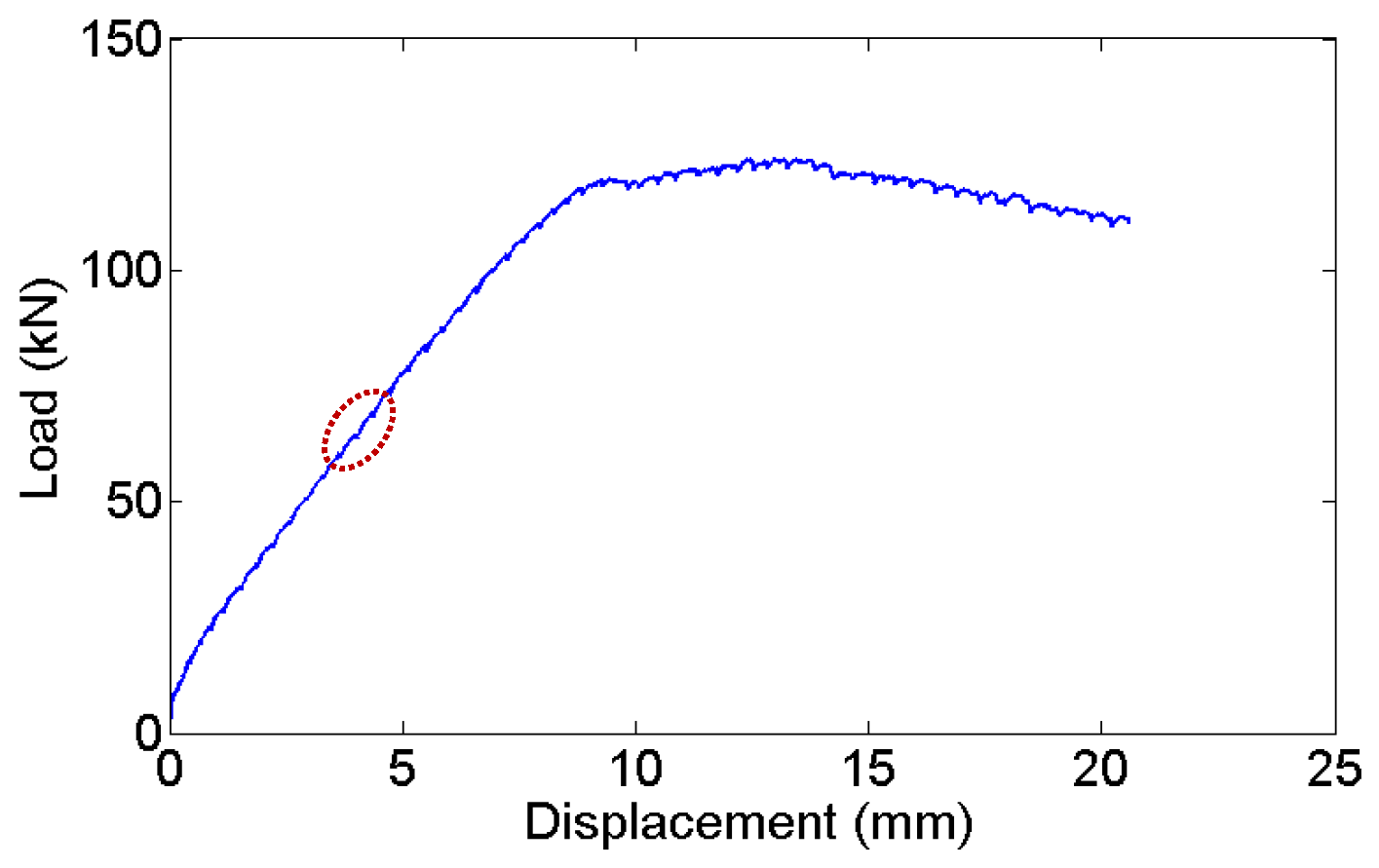

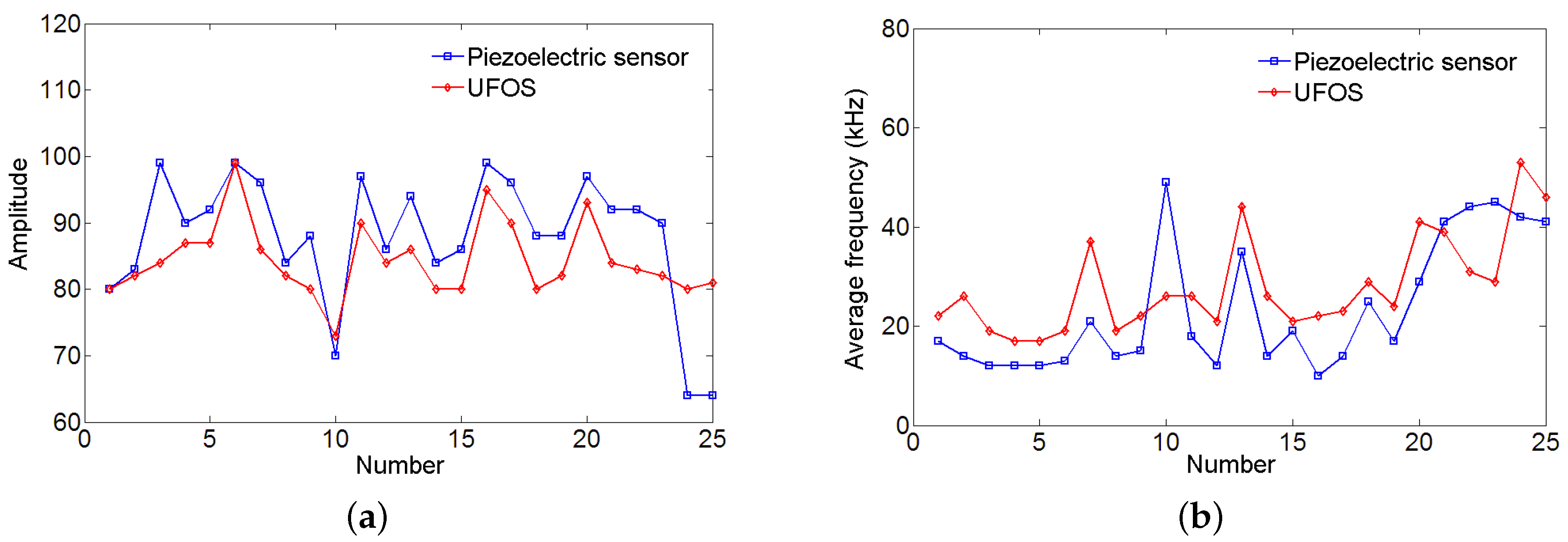
| Sensor No. | Outside Diameter | Height | Wall Thickness | Base Thickness |
|---|---|---|---|---|
| 1 | 20 | 20 | 0.5 | 1.0 |
| 2 | 20 | 1.0 | 1.0 |
© 2018 by the authors. Licensee MDPI, Basel, Switzerland. This article is an open access article distributed under the terms and conditions of the Creative Commons Attribution (CC BY) license (http://creativecommons.org/licenses/by/4.0/).
Share and Cite
Lan, C.; Zhou, W.; Xie, Y. Detection of Ultrasonic Stress Waves in Structures Using 3D Shaped Optic Fiber Based on a Mach–Zehnder Interferometer. Sensors 2018, 18, 1218. https://doi.org/10.3390/s18041218
Lan C, Zhou W, Xie Y. Detection of Ultrasonic Stress Waves in Structures Using 3D Shaped Optic Fiber Based on a Mach–Zehnder Interferometer. Sensors. 2018; 18(4):1218. https://doi.org/10.3390/s18041218
Chicago/Turabian StyleLan, Chengming, Wensong Zhou, and Yawen Xie. 2018. "Detection of Ultrasonic Stress Waves in Structures Using 3D Shaped Optic Fiber Based on a Mach–Zehnder Interferometer" Sensors 18, no. 4: 1218. https://doi.org/10.3390/s18041218





